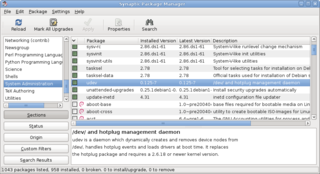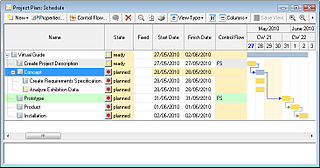An integrated development environment (IDE) is a software application that provides comprehensive facilities for software development. An IDE normally consists of at least a source-code editor, build automation tools, and a debugger. Some IDEs, such as IntelliJ IDEA, Eclipse and Lazarus contain the necessary compiler, interpreter or both; others, such as SharpDevelop and NetBeans, do not.

A package manager or package-management system is a collection of software tools that automates the process of installing, upgrading, configuring, and removing computer programs for a computer in a consistent manner.
IBM DevOps Code ClearCase (also known as IBM Rational ClearCase) is a family of computer software tools that supports software configuration management (SCM) of source code and other software development assets. It also supports design-data management of electronic design artifacts, thus enabling hardware and software co-development. ClearCase includes revision control and forms the basis for configuration management at large and medium-sized businesses, accommodating projects with hundreds or thousands of developers. It is developed by IBM.
Product data management (PDM) is the name of a business function within product lifecycle management (PLM) that denotes the management and publication of product data. In software engineering, this is known as version control. The goals of product data management include ensuring all stakeholders share a common understanding, that confusion during the execution of the processes is minimized, and that the highest standards of quality controls are maintained. PDM should not be confused with product information management (PIM).
Software deployment is all of the activities that make a software system available for use.
In software development, distributed version control is a form of version control in which the complete codebase, including its full history, is mirrored on every developer's computer. Compared to centralized version control, this enables automatic management branching and merging, speeds up most operations, improves the ability to work offline, and does not rely on a single location for backups. Git, the world's most popular version control system, is a distributed version control system.
Open-source software development (OSSD) is the process by which open-source software, or similar software whose source code is publicly available, is developed by an open-source software project. These are software products available with its source code under an open-source license to study, change, and improve its design. Examples of some popular open-source software products are Mozilla Firefox, Google Chromium, Android, LibreOffice and the VLC media player.
Microsoft Visual SourceSafe (VSS) is a discontinued source control program oriented towards small software development projects. Like most source control systems, SourceSafe creates a virtual library of computer files. While most commonly used for source code, SourceSafe can handle any type of file in its database, but older versions were shown to be unstable when used to store large amounts of non-textual data, such as images and compiled executables.
A desktop environment is a collection of software designed to give functionality and a certain look and feel to an operating system.

VMware ESXi is an enterprise-class, type-1 hypervisor developed by VMware, a subsidiary of Broadcom, for deploying and serving virtual computers. As a type-1 hypervisor, ESXi is not a software application that is installed on an operating system (OS); instead, it includes and integrates vital OS components, such as a kernel.
Azure DevOps Server, formerly known as Team Foundation Server (TFS) and Visual Studio Team System (VSTS), is a Microsoft product that provides version control, reporting, requirements management, project management, automated builds, testing and release management capabilities. It covers the entire application lifecycle and enables DevOps capabilities. Azure DevOps can be used as a back-end to numerous integrated development environments (IDEs) but is tailored for Microsoft Visual Studio and Eclipse on all platforms.

Visual Studio is an integrated development environment (IDE) developed by Microsoft. It is used to develop computer programs including websites, web apps, web services and mobile apps. Visual Studio uses Microsoft software development platforms including Windows API, Windows Forms, Windows Presentation Foundation (WPF), Windows Store and Microsoft Silverlight. It can produce both native code and managed code.

Linoma Software was a developer of secure managed file transfer and IBM i software solutions. The company was acquired by HelpSystems in June 2016. Mid-sized companies, large enterprises and government entities use Linoma's software products to protect sensitive data and comply with data security regulations such as PCI DSS, HIPAA/HITECH, SOX, GLBA and state privacy laws. Linoma's software runs on a variety of platforms including Windows, Linux, UNIX, IBM i, AIX, Solaris, HP-UX and Mac OS X.
Plastic SCM is a cross-platform commercial distributed version control tool developed by Códice Software for Microsoft Windows, Mac OS X, Linux, and other operating systems. It includes a command-line tool, native GUIs, diff and merge tool and integration with a number of IDEs. It is a full version control stack not based on Git.

in-STEP BLUE is a project management software program developed and sold by microTOOL GmbH, based in Berlin, Germany. It is designed to assist project managers in developing plans, assigning resources to tasks, tracking progress, managing budgets, requirements, changes and risks as well as analyzing workloads. The tool automatically stores all project results in a central repository shared by all users. Individual project management methods can be supported as well as the agile method Scrum, official methods like the British PRINCE2, the German V-Model XT, the Swiss HERMES method and methods for the automotive industry according to ISO/IEC 15504, also known as SPICE.
Surround SCM is a software configuration management application developed by Seapine Software, now owned by Perforce since 2017. Perforce integrated the software with its Helix ALM product.

BuildMaster is an application release automation tool, designed by the software development team Inedo. It combines build management and ARA capabilities to manage and automate processes primarily related to continuous integration, database change scripts, and production deployments, overall releasing applications reliably. The tool is browser-based and able to be used "out-of-the-box". Its feature set and scope puts it in line with the DevOps movement, and is marketed as "more than a release automatigs together the people, processes, and practices that allow teams to deliver software rapidly, reliably, and responsibly.” It's a tool that embodies incremental DevOps adoption.

Visual Studio Code, also commonly referred to as VS Code, is a source-code editor developed by Microsoft for Windows, Linux, macOS and web browsers. Features include support for debugging, syntax highlighting, intelligent code completion, snippets, code refactoring, and embedded version control with Git. Users can change the theme, keyboard shortcuts, preferences, and install extensions that add functionality.
Perforce Software, Inc. is an American developer of software used for developing and running applications, including version control software, web-based repository management, developer collaboration, application lifecycle management, web application servers, debugging tools and agile planning software.





